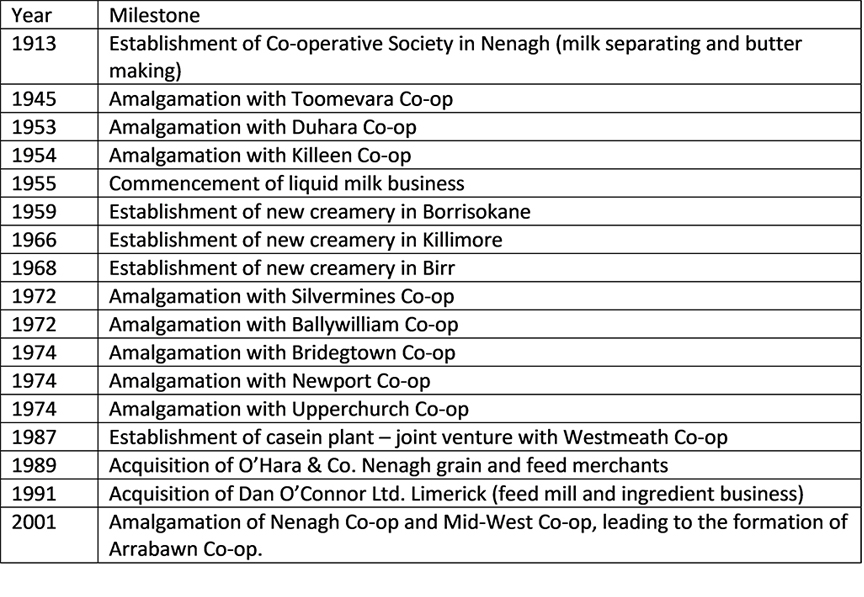According to Forno (2013), the co-operative movement emerged in the 19th Century as a means for individual agri- cultural producers to acquire enhanced:
‘bargaining power when dealing with other businesses, bulk purchasing to guarantee lower prices, obtaining prod- ucts or services otherwise unavailable, gaining market access or broadening market opportunities, improving prod- uct or service quality, securing credit from financial institutions, and increasing income’.
The key characteristics associated with the co-operative movement have remained constant over time. These in- clude: member ownership of the organisation / social enterprise; governance structures enable active participation of membership; and the organisation / social enterprise exists to provide financial benefits to its membership (Gilbert, 2017). Sir Horace Plunkett, the founder of the Plunkett Foundation in Ireland UK, successfully opened Ire- land’s first co-operative in Dromcollagher, Co. Limerick in 1889. The number of agricultural co-operatives in Ireland had increased to over 800 by 1914. In recent decades, there has been a significant restructuring of the agricultural co-operative movement in Ireland vis-s-vis mergers and acquisitions; and some of the largest co-operatives chang- ing their legal status to plcs. Arrabawn Co-operative situated in Nenagh, Co. Tipperary is a prominent agri-based co-operative in Ireland.
Basic information
Cooperation Process Data
Arrabawn Co-operative Society was established in 2001 through the merger of Mid-West Farmers Co-op and Nenagh Co-op. In Ireland and Northern Ireland, milk suppliers have distinct geographic catchment areas (Map 1).
The Arrabawn milk supply catchment area includes portions of Counties Tipperary, Galway, Roscommon, Offaly, Westmeath, Limerick and Clare. The organisation is comprised of three separate divisions. The Dairy Ingredients Division based in Nenagh produces a wide range of products. These include: butter, acid casein, sodium/ calcium caseinate, skim milk powder and sweet whey derived from the acid casein process. The Consumer Foods Division based in Kilconnell provides fresh milk, cream and butter to retailers across Ireland. Finally, the Agri Division sells feedstuff and general agricultural supplies / equipment through its 13 agri-retail stores (inclusive of 3 general hardware stores located in Nenagh, Newport and Mountbellow) and feed manufacturing facilities through Greenvale Animal Feeds and Dan O’Connor Feeds. In 2016, the co-operative. had a turnover of €199.7m and a profit before tax of €4.5m. Furthermore, the co-operative also invested €7.2m on capital infrastructure, with a significant proportion of the investment spent in the milk processing plant in Nenagh.
Arrabawn Co-operative is a commercial entity, which seeks to provide the best price for commodities produced by its membership; and the profits accrued through commercial trading are re-invested back into the company / enterprise. This adheres to the core philosophy of the co-operative movement. Similar to other co-operatives in the country, Arrabawn has grown significantly since its establishment as Nenagh Co-operative in 1913. The growth has occurred as a consequence of mergers and acquisitions of neighbouring co-operatives and enterprises; and diver- sification activities. The key milestones associated with the development of Arrabawn Co-operative are outlined in the following table.
Table: Key Milestones in the Development of Arrabawn Co-operative
Arrabawn Co-operative has 970 milk suppliers and each supplier is a shareholder in the company. In order to supply milk into the co-operative, a farmer has to be member. The CEO (chief executive officer) and management team over- see the daily operations of the co-operative. These officers report directly to a board of directors (18 members). This board are also responsible developing and honing strategic policies related to the future sustainable development of the co-operative. The Representative Committee elects the board members after the Annual General Meeting of the co-operative. The board members serve a 5-year term before requiring re-election. Any significant policy changes (including payment of dividends and reinvestment initiatives) are voted by the membership at the AGM. In addition to the board of directors, area representatives represent the interests of farmers throughout the Arrabawn catch- ment area. Currently, there are 60 area representatives who report on various operational issues / challenges faced by the membership within their respective geographic area. A big challenge faced by large agricultural co-operatives is the recruitment of new board members and area representatives. According to the representative from Arrabawn, there are occasions when only one candidate puts their name forward to be an area representative. A lack of interest in such positions may stem from the amount of time spent representing the interests of farmers. In addition, the attendance rates at AGMs can vary in accordance with the financial performance; and key strategic policy issues.
Arrabawn Co-operative provides numerous supports and services to farmers. Prominent examples include: milk quality testing services in order to allow farmers produce high quality milk; mastitis control workshops; soil fertility services; forage analysis; and seed quality analysis. In addition to the core business of the co-operative, Arrabawn provides a number of learning and networking opportunities for its membership with farm walks being a prominent example. A farm walk allows a group of farmers to have a training and / or information-sharing workshop on a farm holding. An independent agricultural advisor / consultant or research expert provides information on a specified topic / theme. The host farmer can demonstrate how he / she is adhering to best practices. Sometimes, the expert speaker or other farmers can offer guidance or advice on how to improve operations on the farm. A farm walk is an informal unaccredited learning tool and allows farmers to engage in experiential and active learning methodologies. The Arrabawn co-operative has organised numerous farm walks, in co-operation with TEAGASC (national agricultural advisory service) through its Milk for Profit Programme. This advisory support programme enables members of the co-operative to develop robust operating systems to withstand global milk price fluctuations. This ensures farmers can optimise milk output whilst enhancing the quality of the product. The farm walks cover an array of topics and prominent examples include:
- Financial management and planning
- Compact calving
- Grass utilisation
- Breeding management
- Herd health
- Milk quality
Farm walks offer an opportunity for farmers to develop and enhance knowledge, competencies and skillsets in a spe- cific topic. The demonstration of best practices on a commercial host farm provides motivation for participants on the farm walk to replicate the best practices within their respective farms, thereby improving the overall commodity quality and / or volume. In turn, this will lead to enhanced productivity and the receipt of a better price (usually, but dependent on performance of the relevant global commodity market) from the co-operative. The representative from Arrabawn has stated that the farm walks were very successful as farmers were able to share their personal experiences and learn from each other through an informal learning environment. The farm walks also offered an op- portunity for farmers to become acquainted with the latest developments and innovations in farm safety. Farmers usually would not attend a workshop solely devoted to farm safety but it can be easily incorporated into a farm walk. There is a continuous requirement to encourage farm safety techniques and procedures as the agricultural sector is prone to recording the highest rates of workplace injuries each year. For example, 25 individuals received fatal injuries within the Irish agricultural sector in 2016 (Health and Safety Authority, 2018).
Agricultural co-operatives have responded to significant restructuring within the sector in recent decades. The small independent (local) co-operative has been replaced by a much larger entity. In fact some co-operatives (Kerry Ingredients) have changed their legal status from co-operatives to public limited companies. This has been essen- tial for financial sustainability of the sector. The price of commodities (including milk) is being dictated by global market prices. The abolition of European milk quotas led to a spike in milk production and an oversupply of milk. Consequently, farmers were provided a lower price for their produce. However, farmers are able to acquire a higher price for their produce during a period of global shortages. Therefore, the agricultural processing sector has become embedded within a globalised economy.
The appointment of new board members to a co-operative and area representatives requires the provision of ad- equate training and up-skilling workshops. In addition, current board members / area representatives might also require further training in light of policy or regulatory changes. Farmers would be accustomed with the financial, management and regulatory procedures associated with operation of an individual farm holding but would be lack- ing in governance expertise of a large, dynamic and multi-sectoral enterprise such as a co-operative. Therefore, bespoke training should be provided on co-operative structures and functions with a specific emphasis placed on legal structure, financial management and administration; health and safety; marketing; and technical issues. The provision of courses on leadership and governance could also be very beneficial for board members of an agricultural co-operative.
The utilisation of farm walks provides an effective opportunity for informal learning amongst farming entrepreneurs. However, there is a lack of information within the literature on the learning approaches and techniques to be adopt- ed within a farmyard setting. A farm walk provides an opportunity for farmers to develop and hone a wide variety of skills. Prominent examples include:
- Time management
- Strategic planning skills
- Health and safety management skills
- Communication skills;
- Approaches/practices to improve efficiency; and
- Use of technology to improve efficiency.
Advice/Recommendation
By working together we aim to ensure that all Arrabawn suppliers are equipped with the necessary skills and knowl- edge required to run a profitable dairy enterprise.
The objectives of the programme are:
- To increase grass growth and utilisation on farms
- To upskill suppliers in the areas of financial planning and budgeting
- To improve the six week calving rate and calving interval from the current co-op averages of 60% and 389 days
- To increase milk solids production per cow through optimum grassland management and improvements in herd fertility
- To improve milk quality and maximise compliance with the sustainable dairy assurance scheme.
Queries/Questions
- In what ways, can a farmer facilitate an effective farm walk on his / her holding? How can a positive (and informal) environment be created in such a setting?
- What role(s) can you play within the co-operative movement?



 Čeština
Čeština  English
English  Français
Français  Deutsch
Deutsch  Italiano
Italiano  Slovenščina
Slovenščina  Español
Español 






